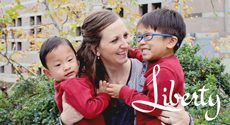We saw her face. We fell in love. Nothing else mattered.
My husband and I simply wanted to be parents and we knew in our hearts that our children were in China; we just had to go get them. Like most parents to be, we hoped and prayed that our children would be healthy. Our first child’s SN was minor and had resolved by the time we brought him home. Imagine our delight when our agency showed us the file of a beautiful baby girl with a “repaired” imperforate anus. We were ecstatic (and considered ourselves lucky) to be bringing home another healthy child!
We did not have a reason to think anything else. No one we talked to told us any differently, not the multiple pediatricians we talked to and not the international adoption doctor we consulted. We were told she would suffer from chronic constipation and we would need to watch her diet, and possibly give her a laxative.
WOW! Doesn’t that sound easy?
I am thankful everyday that we went through her adoption wearing rose-colored glasses. God was protecting us. With tears in my eyes as I type this, the painful truth is if we had known what we know now, we would have said no. That absolutely breaks my heart. My little girl is exactly where she is supposed to be. She was the missing link in our family and she completes our perfect family of four. I can’t imagine one single minute of one single day without her in my world.
I cannot tell you our journey has been easy. It has been so very hard. Every time we turned around, we were thrown another curve ball with her needs.
It started in China when we opened up her diaper. We were horrified by what we saw. We did not know what was wrong, but we knew that it definitely did not look right. I found myself overwhelmed and unprepared for her needs. Post-adoption depression is real and not talked about nearly enough.
Trauma is real for these kids and it is so difficult at times. I was not prepared for the need to travel for care. I was not prepared for the enormity of the “re-do” surgery and recovery. I was not prepared that my daughter might be the “smelly girl” at school, a thought that brings me to tears. I was not prepared for a lifetime of daily enemas.
Our journey has been long. Our journey has been hard, but it has also been so worth it!
People often ask me if I would do it again and the answer is YES! In a heartbeat I would adopt another ARM child, however my family is complete. So now, my calling is to help others. I want to help other families on this hard, wonderful, and often tearful journey.
I was very alone when we went through all the surgeries and recovery for my daughter. I found myself looking to the internet for support and started finding other moms that were traveling the same road. Two years ago, on a whim, I stated a FB group for moms with children born with an ARM and adopted internationally. The group, which started with four women, has grown to over 200 members and is an amazing support system and community.
In an effort to help my daughter, I have read everything I can get my hands on regarding ARMs. I have talked to every professional I can find that will talk about this defect, and it has been my mission to share what I have learned with others. I am happy to chat with potential parents as I feel that knowledge is power.
I have put together a list of the most commonly asked questions (and answers) that I get and shared it below.
– guest post by Heidi
Frequently Asked Questions about Anal Atresia/Imperforate Anus
Q: What is the difference between imperforate anus and anal atresia?
A: When reading a file these terms appear to be interchangeable and essentially mean the same thing. The proper terminology for this defect is Anorectal Malformation (or ARM).
Q: What is an anorectal malformation (aka imperforate anus)?
A: An ARM is a spectrum of abnormalities of the rectum and anus. There are many possible abnormalities such as:
• The absence of an anal opening.
• The anal opening in the wrong place.
• A connection, or fistula, joining the intestine and urinary system.
• A connection joining the intestine and vagina.
• In females, the intestine can join with the urinary system and vagina in a single opening, known as a cloaca.
Q: What is the incidence of ARM?
A: There is no known cause for anorectal malformations and most cases are isolated and do not run in families. This birth defect occurs in one in every 5,000 live births. It is more common among Asians and is somewhat more common in boys than in girls.
Q: Why do some children require a colostomy at birth and some do not with this defect?
A: If there is a fistula (opening) to the skin, urethra or vagina, and the newborn is able to pass stool then often a colostomy is not needed. If there is no anal opening and the newborn is unable to pass stool then a colostomy will be required. Once the anal opening is made, the colostomy can be taken down.
However, in China, often the newborn is given a colostomy regardless of the type of defect. This is done as a life saving maneuver. The anoplasty – or creation of the anus – can be done in China, or more ideally by an expert once home.
Q: What is the name of the surgery to repair this defect?
A: The PSARP (posterior sagittal anorectoplasty or pull-through procedure) was introduced by Dr. Alberto Pena in 1980. This surgical procedure revolutionized the treatment and outcome for these children. Often, children adopted from China do not receive this surgical procedure and an older technique may be used. A video and more information on this procedure can be viewed here.
Q: If the newborn is able to pass stool through a fistula how many surgeries are needed to repair the defect?
A: Typically, this can be done in one surgery and is done in the neonatal period and a colostomy is not required.
Q: If the newborn is unable to pass stool and there is no anal opening, how many surgeries are needed?
A: The child will require 3 surgeries. In the first 1-2 days of life, the newborn will need to have a stoma made in order to pass stool (colostomy). After a few months (allowing the child to grow) the surgery can be done to create the anal opening. This operation is followed by a series of anal dilations. Once dilations are complete, the child will have an operation to take down the colostomy and connect the colon to the rectum. The child will then be able to pass stool through the new anus.
Q: What are anal dilations?
A: In order to prevent stricture or narrowing of the anal opening, a series of dilations are required postoperatively. If the anal incision contracts or becomes tight, then it will be very difficult to pass bowel movements. This process typically lasts several months.
Often it is found, in our children adopted from China, that the anal dilations were not done correctly. The child’s anal opening may be too small. In this situation, a “re-do” operation may be required. In some situations, the anal dilations will need to be repeated.
Typically, anal dilations will need to be done again after the “re-do” operation. However there is one surgeon in the US that is doing this procedure and dilations may not be needed.
Q: How common is it for a child adopted from China to need a “re-do” operation?
A: Sadly, this is very common. The surgeons do the life saving maneuver to open the anal opening but often do not place the new anus through the muscle complex. In most cases, unless a “re-do” (PSARP) operation is performed, the child will have difficulty achieving social continence. You need a very highly skilled and trained surgeon to perform this type of surgery.
Q: What does a “re-do” operation entail?
A: Most families travel to an expert to have this surgery done. The day before the surgery, an NG tube (a tube from the nose to the stomach) is placed and the child is given golytely to clean the colon. The typical protocol is to have the child remain NPO (nothing by mouth, no food or drink) for an average of 7 days post-operatively. The child is given nutrition from an IV. About a month after the surgery, the child will require anal dilations be performed by the parents for about 4-6 months (but there is one surgeon who is doing a new procedure where anal dilations may not be needed).
Some surgeons will place a colostomy for the “re-do” and the child will require another surgery to take down the colostomy once the anus has healed.
Q: Are there any other birth defects associated with an ARM?
A: Children with ARMs can fall on the VACTERL association spectrum. If a child is diagnosed with VACTERL, they typically have 3 or more of the anomalies listed below. It is important to understand that most children are screened for these anomalies in China. Often parents are “surprised” to learn about these anomalies once home.
V – vertebral anomalies – the most common thing we see in our children is a tethered cord
A – anorectal malformation
C – Cardiac or heart defects
TE – tracheoesophageal atresia/fistula
R – renal or kidney (this is very commonly seen in our ARM kids)
L – limb abnormalities
In addition to the above anomalies, girls born with an ARM often have gynecological concerns/anomalies (including cloaca) and hypospadias is often found in boys.
Q: Will my child be continent?
A: As moderator of a large adoption support group, I get this question asked a lot. It is often difficult to answer, as every defect is so different and there are so many factors to consider when determining continence. It is important to know that the large majority of ARM children will always struggle to some degree with their bowel movements and some struggle more than others. Some children experience stool leakage and soiling more than others. Most ARM children will potty train later than other children. However, almost all of these children can remain clean and in normal underwear at typical potty training age along with their peers with bowel management.
When discussing continence or soiling, there are three factors to consider.
1. The quality of the pelvic muscles. Abnormal muscles may result from poor development as commonly seen in ARM children. Abnormal nerves may be a result of congenital neurologic anomalies such as a tethered cord or spine bifida.
2. The ability to sense stool. The ability to sense the presence of stool in the rectum is either present or absent. This will vary from child to child. If absent, conscious control of the pelvic muscles and the anal sphincters may be learned as the child gets older.
3. Chronic constipation. Chronic constipation will decrease the ability to sense the presence of stool. The relief of constipation can improve this rectal sensation.
It is crucial that constipation is prevented in these children in order to remain continent and free from soiling.
The most important thing to know is that with successful bowel management ARM children can be socially continent and wear normal underwear!
Q: What is bowel management?
A: Children can achieve bowel control with a daily stimulant laxative (senna based product such as ex-lax) or a daily large volume enema. Some children can achieve continence (free from soiling) though diet alone, however, this is the exception and not the norm. The goal of the daily laxative or enema is for the child to completely empty the colon at a predictable time each day. Once the colon is clean then the child should remain clean and in underwear the rest of the day. Often, families will travel to an expert to determine a specialized plan tailored to each child.
There are procedures that can be done which allow children to receive an antegrade enema as opposed to a rectal enema. These children receive an enema via a catheter inserted in a small hole their abdomen (usually in the bellybutton) instead of the rectum. These procedures are commonly known as the Malone or appendicostomy, as well as cecostomy.
Q: What is everyday life like with a child born with an ARM?
A: This answer will vary from family to family as every child born with an ARM is different, but the one thing we all have in common is poop! Yep, our lives revolve around our child’s pooping schedule.
The few that are able to manage with diet watch their child’s diet very closely and make adjustments according to the child’s stool output. Preventing constipation is key in these children, so parents intervene as necessary with things such as enemas, suppositories, and laxatives. Often ARM children need a bowel management program, especially in their early pre-school and school age years.
Those that manage with laxatives also tend to keep an eye on diet. These children typically sit on the potty everyday for 30 – 40 minutes. They need to completely evacuate the colon in order to remain clean the rest of the day.
Those that manage with enemas (rectal or antegrade) spend, on average, one hour a day with the routine. Most of these kids have more leeway in their diet, although some foods may cause issues.
Managing the child’s bowel needs is and will be a lifelong reality. As the child grows and changes, so will bowel management. If the child experiences soiling, then tweaking of the regimen will be needed. It’s important for the family to find an expert that understands this and that will be there for them throughout the child’s life.
Q: Do the children in China receive bowel management?
A: In my experience, the majority of the children in China do not receive bowel management. However, if they were fortunate enough to reside in a medical foster care home/program, it is possible that they did receive some bowel management.
Most of the children represented in our support group come home to us very backed up (constipated) which can present itself in one of two ways. The child may appear to be incontinent and stool non-stop. Or the child may not stool at all. Regardless, once home, parents should have the stool tested for parasites to rule out an infection and should obtain an abdominal x-ray to determine if the child is constipated. The large majority of the time, the child is found to be very constipated and a bowel clean-out is needed.
Recommended Resources:
Nationwide Children’s Pelvic Reconstruction Center
Cincinnati Children’s Colorectal Center
UCSF – overview of Imperforate Anus



























Love this post! Thank you for sharing Heidi!
Amazingly informative post. Thank you so much for taking the time and effort to share. Our sweet little 6month old grandson is soon going to have his pull through surgery done. This post gave us so much insight we did not have before. Thank you again. I hope your beautiful little daughter is doing well.